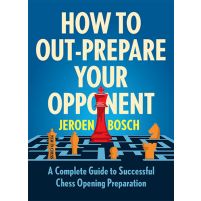How to Out-Prepare Your Opponent by Jeroen Bosch is on the shortlist for the English Chess Federation Book of the Year 2022.
The content below is from Chapter 7 of the book. It is interesting to see how Jeroen objectively shows the pros and cons of playing your own systems.
Enjoy his insights and maybe you can even use his analysis of this interesting sideline of the Old Indian to out-prepare your opponent!
*****
I’ve been the author/editor of 14 volumes called Secrets of Opening Surprises (New In Chess, 2003-2012), and so it would seem strange not to add a chapter on surprise variations or lines that quickly leave the main theoretical path. However, this chapter and the next one (about main lines) are – to paraphrase William James – separate on the surface, but connected if you think about it more deeply. Avoiding the beaten track automatically means that you have some basic knowledge about where the main roads lie. Indeed, whether you opt for a main line or a sideline is ideally a conscious decision on your part. In this chapter, I will divulge some personal favourites (and a few SOS-lines) and talk about the pros and cons of the ‘SOS-approach’. In Chapter 8, we will move to main lines and try to end with some general conclusions.
Let’s start with a game I played in my first Dutch Championship. Three days before the tournament started, I had handed in my final thesis at the university. Having to do all my preparation work during the tournament, I designed a kind of hit-and-run strategy, changing my openings as much as possible, and varying between main lines and sidelines. This did not always work out perfectly. Indeed, in the first round I lost as Black against Van der Wiel with a dubious Sicilian (the Pin Variation) – see the notes to the game Galjé-Hendriks, cr 1988, in Chapter 3. However, then came another Black game against the highest rated participant.
It’s possible that Sokolov did not take me entirely seriously, and my choice of opening (the odd 3...♗f5) may have somewhat clouded his judgement as well. After all, White should always be better against such an opening system, right? This strange Old Indian has served me well over the years in situations where I needed to win. Not a lot of white players will devote their energy to preparing for 3...♗f5, and this means that the fight starts immediately. Indeed, in my experience, many white players avoid an immediate crisis by answering the bishop move with the sensible 4.♘f3. Play then often resembles the King’s Indian.
The next game was played in the tiebreak of a knock-out event. I had lost the first rapid game as White and now needed to win with Black to stay in the match.
On the one hand, Black succeeded in drawing his opponent into his own territory by playing a rare move: 3...♗f5. On the other hand, let’s not forget that the resulting structure in the game might just as well have arisen from a King’s Indian. Surely, White was not entirely without a clue. Moreover, while playing 3...♗f5 means avoiding theory to some extent, it also means that Black has to have a passing familiarity with Glek’s system. Indeed, had White opted for 13.f4, 13...♘f6 14.♗f3 ♗g4 would have transposed into a main line from that particular KID.
I mentioned above that this Old Indian with 3...♗f5 is not that good, but also not that bad. We have seen that White may be able to preserve some opening advantage with both 4.f3 and 4.♘f3, but this edge is nothing special. In my opinion, if there is any move that can lay claim to ‘refuting’ 3...♗f5, it is the modest-looking 4.g3.
The above mini-survey of this Old Indian line had several purposes. If you like what you saw, you might perhaps like to try it out yourself some time – you have a sound basis now! From the game quotations, you can see that I have played this line on quite a number of occasions: both when I needed to win (in rapid or blitz tiebreak situations), but also when I wanted to surprise my opponent or avoid theory. At the same time, I hope to have demonstrated (especially in the notes to Janssen-Bosch) that it isn’t always possible to avoid all theory.

